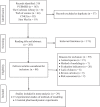Modeling methods for busulfan-induced oligospermia and asthenozoospermia in mice: a systematic review and meta-analysis
- PMID: 36508035
- PMCID: PMC9840741
- DOI: 10.1007/s10815-022-02674-y
Modeling methods for busulfan-induced oligospermia and asthenozoospermia in mice: a systematic review and meta-analysis
Abstract
Objective: Modeling methods for busulfan-induced oligoasthenozoospermia are controversial. We aimed to systematically review the modeling method of busulfan-induced oligospermia and asthenozoospermia, and analyze changes in various evaluation indicators at different busulfan doses over time.
Methods: We searched the Cochrane Library, PubMed databases, Web of Science, the Chinese National Knowledge Infrastructure, and the Chinese Biomedical Literature Service System until April 9, 2022. Animal experiments of busulfan-induced spermatogenesis dysfunction were included and screened. The model mortality and parameters of the evaluation indicators were subjected to meta-analysis.
Results: Twenty-nine animal studies were included (control/model: 669/1829). The mortality of mice increased with busulfan dose. Significant spermatogenesis impairment occurred within 5 weeks, regardless of busulfan dose (10-40 mg/kg). Testicular weight (weighted mean difference [WMD]: - 0.04, 95% CI: - 0.05, - 0.03), testicular index (WMD: - 2.10, 95% CI: - 2.43, - 1.76), and Johnsen score (WMD: - 4.67, 95% CI: - 5.99, - 3.35) were significantly decreased. The pooled sperm counts of the model group were reduced by 32.8 × 106/ml (WMD: - 32.8, 95% CI: - 44.34, - 21.28), and sperm motility decreased by 37% (WMD: - 0.37, 95% CI: - 0.47, - 0.27). Sperm counts decreased slightly (WMD: - 3.03, 95% CI: - 3.42, - 2.64) in an intratesticular injection of low-dose busulfan (4 - 6 mg/kg), and the model almost returned to normal after one seminiferous cycle.
Conclusion: The model using low-dose busulfan (10 - 20 mg/kg) returned to normal after 10 - 15 weeks. However, in some spermatogenesis cycles, testicular weight reduction and testicular spermatogenic function damage were not proportional to busulfan dose. Sperm counts and motility results in different studies had significant heterogeneity. Standard protocols for sperm assessment in animal models were needed to reduce heterogeneity between studies.
Keywords: Asthenospermia; Busulfan; Mouse; Oligoasthenospermia; Oligospermia; Spermatogenic dysfunction; System evaluation.
© 2022. The Author(s), under exclusive licence to Springer Science+Business Media, LLC, part of Springer Nature.
Conflict of interest statement
The authors declare no competing interests.
Figures








Similar articles
-
Sertindole for schizophrenia.Cochrane Database Syst Rev. 2005 Jul 20;2005(3):CD001715. doi: 10.1002/14651858.CD001715.pub2. Cochrane Database Syst Rev. 2005. PMID: 16034864 Free PMC article.
-
Early erythropoietin for preventing red blood cell transfusion in preterm and/or low birth weight infants.Cochrane Database Syst Rev. 2006 Jul 19;(3):CD004863. doi: 10.1002/14651858.CD004863.pub2. Cochrane Database Syst Rev. 2006. Update in: Cochrane Database Syst Rev. 2012 Sep 12;(9):CD004863. doi: 10.1002/14651858.CD004863.pub3. PMID: 16856062 Updated.
-
Systemic interventions for treatment of Stevens-Johnson syndrome (SJS), toxic epidermal necrolysis (TEN), and SJS/TEN overlap syndrome.Cochrane Database Syst Rev. 2022 Mar 11;3(3):CD013130. doi: 10.1002/14651858.CD013130.pub2. Cochrane Database Syst Rev. 2022. PMID: 35274741 Free PMC article.
-
[Icariin improves busulfan- and cyclophosphamide-induced reproductive function damage in male mice].Zhonghua Nan Ke Xue. 2025 Jan;31(1):25-33. Zhonghua Nan Ke Xue. 2025. PMID: 40783969 Chinese.
-
Late erythropoietin for preventing red blood cell transfusion in preterm and/or low birth weight infants.Cochrane Database Syst Rev. 2006 Jul 19;(3):CD004868. doi: 10.1002/14651858.CD004868.pub2. Cochrane Database Syst Rev. 2006. Update in: Cochrane Database Syst Rev. 2012 Sep 12;(9):CD004868. doi: 10.1002/14651858.CD004868.pub3. PMID: 16856064 Updated.
Cited by
-
Ferroptotic Pathway Activation in Spermatogonia: A Novel Mechanism of Busulfan-Induced Testicular Injury.Biology (Basel). 2025 May 23;14(6):594. doi: 10.3390/biology14060594. Biology (Basel). 2025. PMID: 40563846 Free PMC article.
-
DDX58 expression promotes inflammation and growth arrest in Sertoli cells by stabilizing p65 mRNA in patients with Sertoli cell-only syndrome.Front Immunol. 2023 Mar 22;14:1135753. doi: 10.3389/fimmu.2023.1135753. eCollection 2023. Front Immunol. 2023. PMID: 37033952 Free PMC article.
References
-
- Wang H. Chen L [A brief review of animal model of spermatogenesis dysfunction] Chin J Hum Sex. 2017;26:102–104.
Publication types
MeSH terms
Substances
Grants and funding
LinkOut - more resources
Full Text Sources
Miscellaneous

